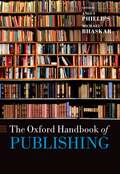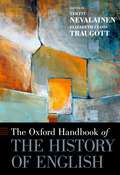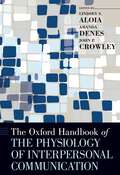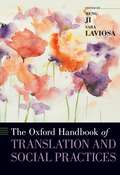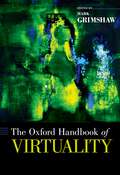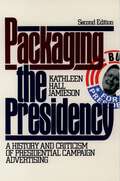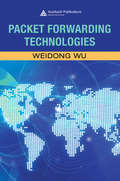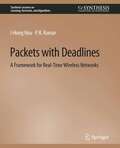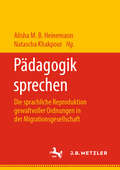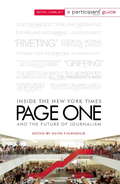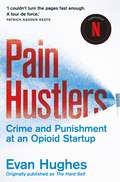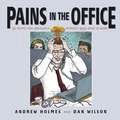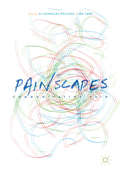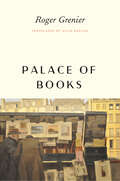- Table View
- List View
The Oxford Handbook of Publishing
Publishing is one of the oldest and most influential businesses in the world. It remains an essential creative and knowledge industry, worth over $140 billion a year, which continues to shape our education and culture. Two trends make this a particularly exciting time. The first is the revolution in communications technology that has transformed what it means to publish; far from resting on their laurels and retreating into tradition, publishers are doing as they always have - staying on the cutting edge. The second is the growing body of academic work that studies publishing in its many forms. Both mean that there has never been a more important time to examine this essential practice and the current state of knowledge. The Oxford Handbook of Publishing marks the coming of age of the scholarship in publishing studies with a comprehensive exploration of current research, featuring contributions from both industry professionals and internationally renowned scholars on subjects such as copyright, corporate social responsibility, globalizing markets, and changing technology. This authoritative volume looks at the relationship of the book publishing industry with other media, and how intellectual property underpins what publishers do. It outlines the complex and risky economics of the industry and examines how marketing, publicity, and sales have become ever more central aspects of business practice, while also exploring different sectors in depth and giving full treatment to the transformational and much discussed impact of digital publishing. This Handbook is essential reading for anyone interested in publishing, literature, and the business of media, entertainment, culture, communication, and information.
The Oxford Handbook of the History of English: Studies Based On The Corpus Of Early English Correspondence (Oxford Handbooks #15)
by Terttu NevalainenThe availability of large electronic corpora has caused major shifts in linguistic research, including the ability to analyze much more data than ever before, and to perform micro-analyses of linguistic structures across languages. This has historical linguists to rethink many standard assumptions about language history, and methods and approaches that are relevant to the study of it. The field is now interested in, and attracts, specialists whose fields range from statistical modeling to acoustic phonetics. These changes have even transformed linguists' perceptions of the very processes of language change, particularly in English, the most studied language in historical linguistics due to the size of available data and its status as a global language. The Oxford Handbook of the History of English takes stock of recent advances in the study of the history of English, broadening and deepening the understanding of the field. It seeks to suggest ways to rethink the relationship of English's past with its present, and make transparent the variety of conditions and processes that have been instrumental in shaping that history. Setting a new standard of cross-theoretical collaboration, it covers the field in an innovative way, providing diachronic accounts of major influences such as language contact, and typological processes that have shaped English and its varieties, as well as highlighting recent and ongoing developments of Englishes--celebrating the vitality of language change over the centuries and the many contexts and processes through which language change occurs.
The Oxford Handbook of the History of English (Oxford Handbooks)
The availability of large electronic corpora has caused major shifts in linguistic research, including the ability to analyze much more data than ever before, and to perform micro-analyses of linguistic structures across languages. This has historical linguists to rethink many standard assumptions about language history, and methods and approaches that are relevant to the study of it. The field is now interested in, and attracts, specialists whose fields range from statistical modeling to acoustic phonetics. These changes have even transformed linguists' perceptions of the very processes of language change, particularly in English, the most studied language in historical linguistics due to the size of available data and its status as a global language. The Oxford Handbook of the History of English takes stock of recent advances in the study of the history of English, broadening and deepening the understanding of the field. It seeks to suggest ways to rethink the relationship of English's past with its present, and make transparent the variety of conditions and processes that have been instrumental in shaping that history. Setting a new standard of cross-theoretical collaboration, it covers the field in an innovative way, providing diachronic accounts of major influences such as language contact, and typological processes that have shaped English and its varieties, as well as highlighting recent and ongoing developments of Englishes--celebrating the vitality of language change over the centuries and the many contexts and processes through which language change occurs.
The Oxford Handbook of the Physiology of Interpersonal Communication (Oxford Handbooks)
by Lindsey Aloia Amanda Denes John P. CrowleyCommunication scholars have long recognized the importance of understanding associations between our bodies and communication messages and processes. In the past decade, there has been an increased focus on the role of physiology in interpersonal interactions, resulting in a surge of research exploring topics related to communication in close relationships. This growing line of research explores topics such as affectionate communication, forgiveness, communication apprehension, and social support. Contributing to the increase in physiological research on communication processes is a greater recognition of the bi-directional nature of the associations between communication and the body. Researchers study both the physiological outcomes of communication episodes (e.g., stress responses to conflict conversations), as well as the effects of physiology on communication process (e.g., the influence of hormones on post-sex communication). The Oxford Handbook of the Physiology of Interpersonal Communication offers a comprehensive review of the most prolific areas of research investigating both the physiological outcomes of interpersonal communication and the effects of physiology on interpersonal interactions. This volume brings together thirty-three leading scholars in the field and draws on research from communication studies, physiology, psychology, and neuroscience. Based on quantitative research methods, the Handbook serves as a resource for both researchers and students interested in investigating the mutual influence of physiology and communication in close relationships.
The Oxford Handbook of the Physiology of Interpersonal Communication (Oxford Handbooks)
Communication scholars have long recognized the importance of understanding associations between our bodies and communication messages and processes. In the past decade, there has been an increased focus on the role of physiology in interpersonal interactions, resulting in a surge of research exploring topics related to communication in close relationships. This growing line of research explores topics such as affectionate communication, forgiveness, communication apprehension, and social support. Contributing to the increase in physiological research on communication processes is a greater recognition of the bi-directional nature of the associations between communication and the body. Researchers study both the physiological outcomes of communication episodes (e.g., stress responses to conflict conversations), as well as the effects of physiology on communication process (e.g., the influence of hormones on post-sex communication). The Oxford Handbook of the Physiology of Interpersonal Communication offers a comprehensive review of the most prolific areas of research investigating both the physiological outcomes of interpersonal communication and the effects of physiology on interpersonal interactions. This volume brings together thirty-three leading scholars in the field and draws on research from communication studies, physiology, psychology, and neuroscience. Based on quantitative research methods, the Handbook serves as a resource for both researchers and students interested in investigating the mutual influence of physiology and communication in close relationships.
The Oxford Handbook of Translation and Social Practices (Oxford Handbooks)
by Sara Laviosa Meng JiThe discipline of translation studies has gained increasing importance at the beginning of the 21st century as a result of rapid globalization and the development of computer-based translation methods. Today, changing political, economic, health, and environmental realities across the world are generating previously unknown inter-language communication challenges that can only be understood through a socially-oriented and data-driven approach. The Oxford Handbook of Translation and Social Practices draws on a wide array of case studies from all over the world to demonstrate the value of different forms of translation - written, oral, audiovisual - as social practices that are essential to achieve sustainability, accessibility, inclusion, multiculturalism, and multilingualism. Edited by Meng Ji and Sara Laviosa, this timely collection illustrates the manifold interactions between translation studies and the social and natural sciences, enabling for the first time the exchange of research resources and methods between translation and other domains' experts. Twenty-nine chapters by international scholars and professional translators apply translation studies methods to a wide range of fields, including healthcare, environmental policy, geological and cultural heritage conservation, education, tourism, comparative politics, conflict mediation, international law, commercial law, immigration, and indigenous rights. The articles engage with numerous languages, from European and Latin American contexts to Asian and Australian languages, giving unprecedented weight to the translation of indigenous languages. The Handbook highlights how translation studies generate innovative solutions to long-standing and emerging social issues, thus reformulating the scope of this discipline as a socially-oriented, empirical, and ethical research field in the 21st century.
The Oxford Handbook of Translation and Social Practices (Oxford Handbooks)
The discipline of translation studies has gained increasing importance at the beginning of the 21st century as a result of rapid globalization and the development of computer-based translation methods. Today, changing political, economic, health, and environmental realities across the world are generating previously unknown inter-language communication challenges that can only be understood through a socially-oriented and data-driven approach. The Oxford Handbook of Translation and Social Practices draws on a wide array of case studies from all over the world to demonstrate the value of different forms of translation - written, oral, audiovisual - as social practices that are essential to achieve sustainability, accessibility, inclusion, multiculturalism, and multilingualism. Edited by Meng Ji and Sara Laviosa, this timely collection illustrates the manifold interactions between translation studies and the social and natural sciences, enabling for the first time the exchange of research resources and methods between translation and other domains' experts. Twenty-nine chapters by international scholars and professional translators apply translation studies methods to a wide range of fields, including healthcare, environmental policy, geological and cultural heritage conservation, education, tourism, comparative politics, conflict mediation, international law, commercial law, immigration, and indigenous rights. The articles engage with numerous languages, from European and Latin American contexts to Asian and Australian languages, giving unprecedented weight to the translation of indigenous languages. The Handbook highlights how translation studies generate innovative solutions to long-standing and emerging social issues, thus reformulating the scope of this discipline as a socially-oriented, empirical, and ethical research field in the 21st century.
Packaging the Presidency: A History And Criticism Of Presidential Campaign Advertising
by Kathleen Hall JamiesonPacket Forwarding Technologies
by Weidong WuAs Internet traffic continues to grow exponentially, there is a great need to build Internet protocol (IP) routers with high-speed and high-capacity packet networking capabilities. The first book to explore this subject, Packet Forwarding Technologies explains in depth packet forwarding concepts and implementation technologies. It covers the
Packet Forwarding Technologies
by Weidong WuAs Internet traffic continues to grow exponentially, there is a great need to build Internet protocol (IP) routers with high-speed and high-capacity packet networking capabilities. The first book to explore this subject, Packet Forwarding Technologies explains in depth packet forwarding concepts and implementation technologies. It covers the
Packets with Deadlines: A Framework for Real-Time Wireless Networks (Synthesis Lectures on Learning, Networks, and Algorithms)
by I-Hong Hou P.R. KumarWith the explosive increase in the number of mobile devices and applications, it is anticipated that wireless traffic will increase exponentially in the coming years. Moreover, future wireless networks all carry a wide variety of flows, such as video streaming, online gaming, and VoIP, which have various quality of service (QoS) requirements. Therefore, a new mechanism that can provide satisfactory performance to the complete variety of all kinds of flows, in a coherent and unified framework, is needed. In this book, we introduce a framework for real-time wireless networks. This consists of a model that jointly addresses several practical concerns for real-time wireless networks, including per-packet delay bounds, throughput requirements, and heterogeneity of wireless channels. We detail how this framework can be employed to address a wide range of problems, including admission control, packet scheduling, and utility maximization. Table of Contents: Preface / Introduction / A Study of the Base Case / Admission Control / Scheduling Policies / Utility Maximization without Rate Adaptation / Utility Maximization with Rate Adaptation / Systems with Both Real-Time Flows and Non-Real-Time Flows / Broadcasting and Network Coding / Bibliography / Authors' Biographies
Pädagogik sprechen: Die sprachliche Reproduktion gewaltvoller Ordnungen in der Migrationsgesellschaft
by Alisha M.B. Heinemann Natascha KhakpourIn diesem Sammelband gehen die Autor*innen der Frage nach, wie Sprache und Gewalt miteinander verwoben sind und wie dieser Zusammenhang für pädagogische Kontexte relevant wird. Dabei wird migrationspädagogische Professionalität aus interdisziplinären Perspektiven heraus diskutiert. Stimmen aus der Kunstwissenschaft, der Erziehungswissenschaft, der Rechtsextremismusarbeit, der Philosophie, sowie aus der pädagogischen und aktivistischen Praxis geben Impulse, um Widersprüche aufzuzeigen, Veränderungen anzustoßen und eine (Weiter-)Entwicklung reflexiver Professionalität zu ermöglichen.
Page Layout (large print)
by RnibThis is an image of a page from a magazine, showing the various graphic elements used in its layout. There is a locator dot shown, which will be at the top left of the page when the image is the right way up. A heavy line shows the edges of the page, which fills the central portion of the diagram. There are descriptive labels to the right and left. This page is divided into two columns with a margin all the way around the page. At the top centre, are two wide unfilled rectangles showing the position of the heading and sub-heading. Right and below these is a textured box with a diagonal cross, showing the position of a photograph. There is another photo to the bottom left of the image. The main part of the page is filled with a dashed texture representing two columns of body text.
Page Layout (UEB contracted)
by RnibThis is an image of a page from a magazine, showing the various graphic elements used in its layout. There is a locator dot shown, which will be at the top left of the page when the image is the right way up. A heavy line shows the edges of the page, which fills the central portion of the diagram. There are descriptive labels to the right and left. This page is divided into two columns with a margin all the way around the page. At the top centre, are two wide unfilled rectangles showing the position of the heading and sub-heading. Right and below these is a textured box with a diagonal cross, showing the position of a photograph. There is another photo to the bottom left of the image. The main part of the page is filled with a dashed texture representing two columns of body text.
Page Layout (UEB uncontracted)
by RnibThis is an image of a page from a magazine, showing the various graphic elements used in its layout. There is a locator dot shown, which will be at the top left of the page when the image is the right way up. A heavy line shows the edges of the page, which fills the central portion of the diagram. There are descriptive labels to the right and left. This page is divided into two columns with a margin all the way around the page. At the top centre, are two wide unfilled rectangles showing the position of the heading and sub-heading. Right and below these is a textured box with a diagonal cross, showing the position of a photograph. There is another photo to the bottom left of the image. The main part of the page is filled with a dashed texture representing two columns of body text.
Page One: Inside The New York Times and the Future of Journalism
by David Folkenflik Participant MediaThe news media is in the middle of a revolution. Old certainties have been shoved aside by new entities such as WikiLeaks and Gawker, Politico and the Huffington Post. But where, in all this digital innovation, is the future of great journalism? Is there a difference between an opinion column and a blog, a reporter and a social networker? Who curates the news, or should it be streamed unimpeded by editorial influence? Expanding on Andrew Rossi's "riveting” film (Slate), David Folkenflik has convened some of the smartest media savants to talk about the present and the future of news. Behind all the debate is the presence of the New York Times, and the inside story of its attempt to navigate the new world, embracing the immediacy of the web without straying from a commitment to accurate reporting and analysis that provides the paper with its own definition of what it is there to showcase: all the news that's fit to print.
Pain Hustlers: Now a major Netflix film
by Evan HughesNow a major film streaming on NETFLIX‘I couldn’t turn the pages fast enough. A tour de force.’ – Patrick Radden Keefe, award-winning author of Empire of Pain'Everyone should read this book' - Sheelagh Kolhatkar, author of Black EdgeJohn Kapoor had already made a small fortune in pharmaceuticals when he developed a highly potent fentanyl-based painkiller that was as addictive as it was effective. Desperate to make the most of his new drug, he brought together an ambitious, persuasive and relentless group of young recruits who were willing to do anything to profit from this seemingly life-chanigng medicine.This is the inside story of hustlers turned millionaires and a shocking exposé of how opioids entered the national bloodstream.'A fast-paced and maddening account' - The New York Times Book ReviewPreviously published as The Hard Sell
Pains in the Office: 50 People You Absolutely, Definitely Must Avoid at Work!
by Andrew HolmesWhat could be worse than being stuck in an office all day? Meetings, deadlines... colleagues. Surely no torture can crush the spirit so completely as prolonged exposure to these people. You?ve faked phone calls to avoid them. You?ve hidden in toilet cubicles until they?ve gone away. At last there?s an effective way to fight back. Pains in the Office will help you identify, shun and plan your revenge on the 50 worst types of people you meet at work. Your job may be awful, you may hate your colleagues with a passion, but here at least is a happy place to retreat into. This is your comfort blanket, hidey-hole and fire escape all rolled into one. Pains in the Office is guaranteed to become as indispensable to the office worker as cigarette breaks and free stationery. It?s the perfect antidote to nightmarish co-workers everywhere!
Pains in the Office: 50 People You Absolutely, Definitely Must Avoid at Work!
by Andrew HolmesWhat could be worse than being stuck in an office all day? Meetings, deadlines... colleagues. Surely no torture can crush the spirit so completely as prolonged exposure to these people. You?ve faked phone calls to avoid them. You?ve hidden in toilet cubicles until they?ve gone away. At last there?s an effective way to fight back. Pains in the Office will help you identify, shun and plan your revenge on the 50 worst types of people you meet at work. Your job may be awful, you may hate your colleagues with a passion, but here at least is a happy place to retreat into. This is your comfort blanket, hidey-hole and fire escape all rolled into one. Pains in the Office is guaranteed to become as indispensable to the office worker as cigarette breaks and free stationery. It?s the perfect antidote to nightmarish co-workers everywhere!
Painscapes: Communicating Pain
by Ej Gonzalez-Polledo Jen TarrThis book brings into dialogue approaches from anthropology, sociology, visual art, theatre, and literature to question what kinds of relations, frames and politics constitute pain across disciplines and methodologies. Each chapter offers a unique window onto the notoriously difficult problem of how pain is defined and communicated. The contributors reimagine the value of images and photography, poetry, history, drama, stories and interviews, not as ‘better’ representations of the pain experience, but as devices to navigate the complexity of pain across different physical, social, and intersubjective domains. This innovative collection provides a new access point to the phenomenon of pain and the materialities, affects, structures and institutions that constitute it. This book will appeal to readers seeking to better understand pain’s complexity and the social and affective ecologies through which pain is known, communicated and lived.
Palace of Books
by Roger GrenierFor decades, French writer, editor, and publisher Roger Grenier has been enticing readers with compact, erudite books that draw elegant connections between the art of living and the work of art. Under Grenier’s wry gaze, clichés crumble, and offbeat anecdotes build to powerful insights. With Palace of Books, he invites us to explore the domain of literature, its sweeping vistas and hidden recesses. Engaging such fundamental questions as why people feel the need to write, or what is involved in putting one’s self on the page, or how a writer knows she’s written her last sentence, Grenier marshals apposite passages from his favorite writers: Chekhov, Baudelaire, Proust, James, Kafka, Mansfield and many others. Those writers mingle companionably with tales from Grenier’s half-century as an editor and friend to countless legendary figures, including Albert Camus, Romain Gary, Milan Kundera, and Brassai,. Grenier offers here a series of observations and quotations that feel as spontaneous as good conversation, yet carry the lasting insights of a lifetime of reading and thinking. Palace of Books is rich with pleasures and surprises, the perfect accompaniment to old literary favorites, and the perfect introduction to new ones.
Palace of Books
by Roger GrenierFor decades, French writer, editor, and publisher Roger Grenier has been enticing readers with compact, erudite books that draw elegant connections between the art of living and the work of art. Under Grenier’s wry gaze, clichés crumble, and offbeat anecdotes build to powerful insights. With Palace of Books, he invites us to explore the domain of literature, its sweeping vistas and hidden recesses. Engaging such fundamental questions as why people feel the need to write, or what is involved in putting one’s self on the page, or how a writer knows she’s written her last sentence, Grenier marshals apposite passages from his favorite writers: Chekhov, Baudelaire, Proust, James, Kafka, Mansfield and many others. Those writers mingle companionably with tales from Grenier’s half-century as an editor and friend to countless legendary figures, including Albert Camus, Romain Gary, Milan Kundera, and Brassai,. Grenier offers here a series of observations and quotations that feel as spontaneous as good conversation, yet carry the lasting insights of a lifetime of reading and thinking. Palace of Books is rich with pleasures and surprises, the perfect accompaniment to old literary favorites, and the perfect introduction to new ones.
Palace of Books
by Roger GrenierFor decades, French writer, editor, and publisher Roger Grenier has been enticing readers with compact, erudite books that draw elegant connections between the art of living and the work of art. Under Grenier’s wry gaze, clichés crumble, and offbeat anecdotes build to powerful insights. With Palace of Books, he invites us to explore the domain of literature, its sweeping vistas and hidden recesses. Engaging such fundamental questions as why people feel the need to write, or what is involved in putting one’s self on the page, or how a writer knows she’s written her last sentence, Grenier marshals apposite passages from his favorite writers: Chekhov, Baudelaire, Proust, James, Kafka, Mansfield and many others. Those writers mingle companionably with tales from Grenier’s half-century as an editor and friend to countless legendary figures, including Albert Camus, Romain Gary, Milan Kundera, and Brassai,. Grenier offers here a series of observations and quotations that feel as spontaneous as good conversation, yet carry the lasting insights of a lifetime of reading and thinking. Palace of Books is rich with pleasures and surprises, the perfect accompaniment to old literary favorites, and the perfect introduction to new ones.
Palace of Books
by Roger GrenierFor decades, French writer, editor, and publisher Roger Grenier has been enticing readers with compact, erudite books that draw elegant connections between the art of living and the work of art. Under Grenier’s wry gaze, clichés crumble, and offbeat anecdotes build to powerful insights. With Palace of Books, he invites us to explore the domain of literature, its sweeping vistas and hidden recesses. Engaging such fundamental questions as why people feel the need to write, or what is involved in putting one’s self on the page, or how a writer knows she’s written her last sentence, Grenier marshals apposite passages from his favorite writers: Chekhov, Baudelaire, Proust, James, Kafka, Mansfield and many others. Those writers mingle companionably with tales from Grenier’s half-century as an editor and friend to countless legendary figures, including Albert Camus, Romain Gary, Milan Kundera, and Brassai,. Grenier offers here a series of observations and quotations that feel as spontaneous as good conversation, yet carry the lasting insights of a lifetime of reading and thinking. Palace of Books is rich with pleasures and surprises, the perfect accompaniment to old literary favorites, and the perfect introduction to new ones.
